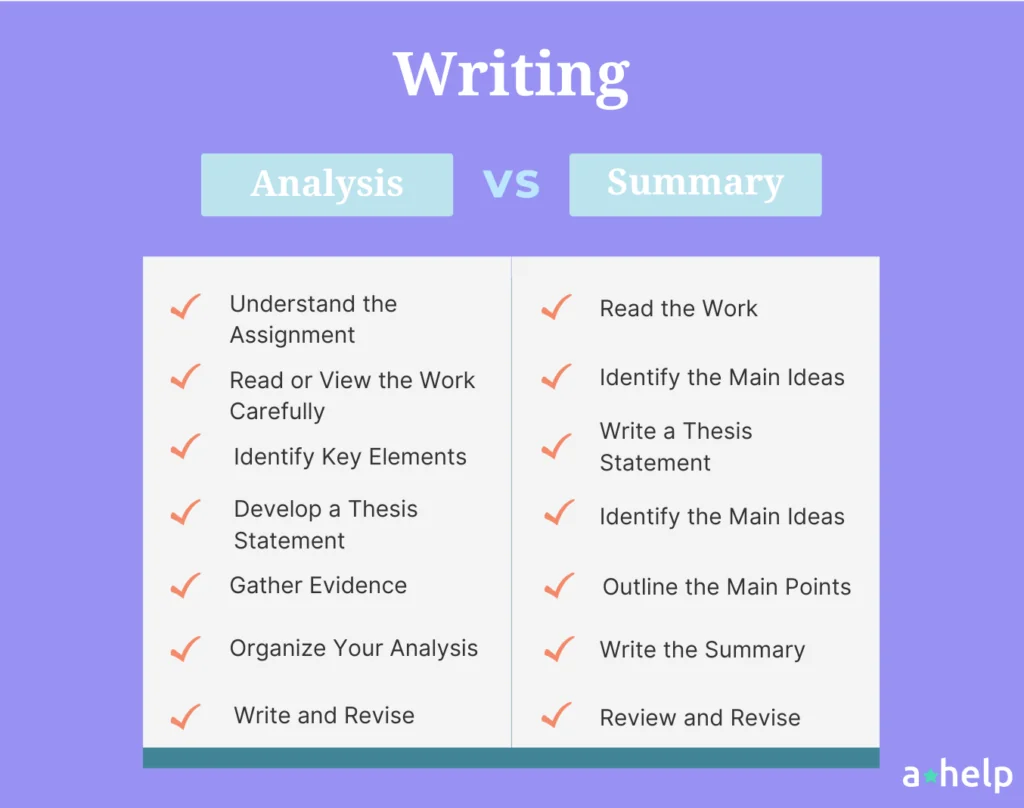If you are a student, you have probably been asked to write both an analysis and a summary at least once throughout your educational journey. Those are common tasks in academic writing, but they serve distinct purposes and require different approaches. The key difference is that an analysis involves examining and interpreting the deeper meaning or implications of a subject, while a summary provides a concise overview of its main points or content. In this article, we’ll discuss the definitions, key differences, and specific steps to writing both a summary and an analysis, with a focus on how these skills can enhance your understanding and critical thinking in a writing center context.

✅ AI Essay Writer ✅ AI Detector ✅ Plagchecker ✅ Paraphraser
✅ Summarizer ✅ Citation Generator
Defining Terms: What is a Summary and What is an Analysis
A summary is a concise, neutral account of the main ideas, events, or arguments of a work, whether it’s a book, an article, or a movie. It distills the content down to its essentials, without offering any interpretation or opinion. The goal of a summary is to provide a clear, understandable overview for someone who may not be familiar with the original work.
An analysis, on the other hand, goes beyond simply recounting the content. It involves examining the elements of a work, such as its structure, themes, and characters, and interpreting their significance. Analysis requires critical thinking and the ability to draw conclusions and make connections between different parts of the work. It’s an exploration of the deeper meaning and implications of a piece.
The Key Differences Between Analysis vs Summary
While both summaries and analyses are important writing skills, they serve different purposes and require different approaches. Here are the main differences.
🧐 Purpose
The primary aim of a summary is to condense information, providing a clear and concise overview of a work’s main points. It strips away the details to present the essence of the story or argument in a nutshell. On the other hand, an analysis seeks to interpret and evaluate the work. It goes beyond merely recounting the events or arguments and delves into the significance, effectiveness, and implications of the elements within the work.
📝 Content
In terms of content, summaries focus on the main points or events of a work without delving into the finer details. They provide a straightforward account of what happens or what is argued, without offering commentary or interpretation. Analyses, however, explore the underlying themes, structures, and meanings of a work. They examine how the elements of the work contribute to its overall impact, considering factors like symbolism, character development, and narrative techniques.
🗣️ Voice
The voice used in a summary is neutral and objective. It aims to present the information in an unbiased manner, without the writer’s personal opinions or interpretations influencing the account. In contrast, analyses are more subjective, reflecting the writer’s perspective and critical thinking. An analysis allows the writer to express their views on the effectiveness of the work, the relevance of its themes, and the implications of its arguments.
🔎 Depth
Finally, the depth of exploration in these two types of writing differs significantly. Summaries are surface-level, providing a broad overview without going into depth about the work’s complexities. They are typically brief and to the point. Analyses, however, go deeper into the nuances of a work. They dissect the components of the work, examining how they interrelate and contribute to the overall meaning or effectiveness. An analysis is more detailed and comprehensive, offering a richer, more insightful exploration of the work.
Here’s a comparison table to help you memorize and visualize the key differences:
| Aspect | Summary | Analysis |
|---|---|---|
| 🧐Purpose | Condense information | Interpret and evaluate |
| 📝Content | Main points | Underlying themes, structures, meanings |
| 🗣️Voice | Neutral, objective | Subjective, reflective of writer’s perspective |
| 🔎Depth | Surface-level | Deep, nuanced |
Explore the new Summarizer Tool to generate custom summaries!
How to Write an Analysis
Writing an analysis requires a structured approach and careful attention to detail. Here’s a more detailed breakdown of each step in the process:
Understand the Assignment
Before you start, it’s important to understand what your analysis should focus on. Read the assignment prompt carefully and clarify any doubts with your instructor. Determine whether you need to analyze a specific element of the work, such as the theme, character development, or narrative structure. Knowing the scope of your analysis will help you stay focused and relevant.
Read or View the Work Carefully
Immerse yourself in the work you’re analyzing. Whether it’s a book, a film, or a painting, engage with it attentively and critically. Take notes as you go, highlighting any details, patterns, or moments that stand out to you. These observations will form the basis of your analysis.
Identify Key Elements
After you’ve familiarized yourself with the work, start identifying the key elements that contribute to its overall meaning. Look for recurring themes, significant symbols, pivotal characters, or impactful scenes. Consider how these elements interact and what they reveal about the work’s message or purpose.
Develop a Thesis Statement
Based on your observations, formulate a thesis statement that captures your interpretation of the work. Your thesis should be clear, arguable, and focused. It should provide a roadmap for your analysis, indicating the aspects you’ll explore and the stance you’ll take.
Gather Evidence
To support your thesis, gather evidence from the work. This might include direct quotes, specific examples, or detailed descriptions of scenes. Make sure your evidence is relevant and directly supports the points you’re making in your analysis.
Organize Your Analysis
Structure your analysis logically. Start with an introduction that presents your thesis statement and gives an overview of the work. Then, divide the body of your essay into paragraphs, each focusing on a different aspect of your thesis. Use topic sentences to introduce each paragraph’s main idea, and make each paragraph flow smoothly into the next. Conclude your analysis by summarizing your main points and reiterating your thesis, possibly with some final reflections on the work’s overall significance.
Write and Revise
Once you have a clear structure, start writing your analysis. Be concise and precise in your language, and make sure each sentence contributes to your argument. After writing your first draft, revise it for clarity, coherence, and logical flow. Check for grammatical errors and make sure your analysis adheres to academic integrity and APA style guidelines, if required. Revising and polishing your analysis will strengthen your argument and enhance the overall quality of your writing.

How to Write a Summary
Writing a summary requires a clear understanding of the original work and the ability to distill its main points into a concise format. Here’s a more detailed look at each step in the process:
- Read the Work: Begin by thoroughly reading or viewing the work you need to summarize. Pay attention to its overall structure and the way the content is organized. Try to grasp the main points and the author’s or creator’s purpose. This initial understanding is crucial for writing an effective summary.
- Identify the Main Ideas: As you read, take note of the key concepts, events, or arguments presented in the work. Look for the central ideas in each section or chapter, and try to understand how they contribute to the overall message or storyline. These main ideas will form the backbone of your summary.
- Write a Thesis Statement: Based on your understanding of the work, create a thesis statement that captures its essence. This statement should be concise and encapsulate the primary focus or argument of the work. It will serve as the guiding idea for your summary.
- Outline the Main Points: Organize the main ideas you’ve identified in the same order as they appear in the original work. Creating an outline will help you structure your summary logically and cover all the important points. This outline doesn’t have to be detailed; it should just provide a roadmap for your summary.
- Write the Summary: Using your outline as a guide, start writing your summary. Use your own words to present the main points, and avoid copying sentences directly from the original work. Keep your summary brief and to the point, focusing on the most important information. Make sure to include your thesis statement at the beginning and summarize the work’s main ideas in a logical order.
- Review and Revise: After writing your summary, review it so that it accurately reflects the main points of the original work. Check for clarity and coherence, and make sure your summary is concise and free of unnecessary details. Revise any parts that need improvement. After all, your summary should maintain academic integrity and avoiding plagiarism.
Comparing Analysis vs Summary: Examples
Let’s take Ray Bradbury’s novel “Fahrenheit 451” as an example:
Summary: “Fahrenheit 451” is a dystopian novel set in a future where books are banned and “firemen” burn any that are found. The story follows Guy Montag, a fireman who becomes disillusioned with his role in suppressing knowledge and begins to seek out and read forbidden books. His quest for understanding leads him to question the society he lives in and ultimately rebel against it.
Analysis: In “Fahrenheit 451,” Ray Bradbury explores themes of censorship, the role of technology in society, and the search for knowledge. Through the character of Montag, Bradbury critiques a society that values conformity and entertainment over critical thinking and individualism. The burning of books symbolizes the suppression of dissenting ideas, while Montag’s journey represents the transformative power of literature.
Comparison
In the provided examples, the summary of “Fahrenheit 451” condenses the plot into a concise overview, focusing on the main events and characters. It presents an objective and factual account of Guy Montag’s journey from a conformist fireman to a seeker of knowledge in a dystopian society where books are banned. The summary is neutral, avoiding any interpretation or evaluation of the themes or the author’s intentions.
On the other hand, the analysis of “Fahrenheit 451” goes beyond the surface-level events to explore the underlying themes and significance of the novel. It interprets the story as a critique of censorship, the impact of technology on society, and the value of critical thinking and individualism. The analysis is subjective, reflecting the writer’s perspective and critical thinking. It presents an argument about the deeper meaning of the novel, supported by evidence from the text, such as the symbolism of fire and the character development of Montag.
Conclusion
Understanding the differences between summary and analysis is necessary for developing effective writing skills, especially in a writing center context. A summary provides a concise overview of a work, while an analysis offers a deeper exploration of its elements and meanings. Both are valuable tools for academic and professional writing, and mastering them can enhance your critical thinking, academic integrity, and ability to communicate complex ideas.
FAQ
Follow us on Reddit for more insights and updates.





Comments (0)
Welcome to A*Help comments!
We’re all about debate and discussion at A*Help.
We value the diverse opinions of users, so you may find points of view that you don’t agree with. And that’s cool. However, there are certain things we’re not OK with: attempts to manipulate our data in any way, for example, or the posting of discriminative, offensive, hateful, or disparaging material.